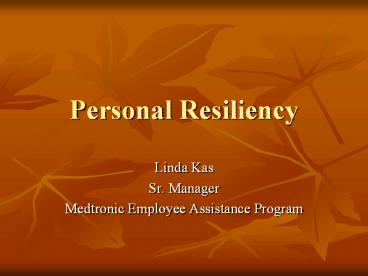Personal Resiliency - PowerPoint PPT Presentation
1 / 15
Title:
Personal Resiliency
Description:
Personal Resiliency Linda Kas Sr. Manager Medtronic Employee Assistance Program Resilience The ability to spring back or rebound after being stretched, bent or ... – PowerPoint PPT presentation
Number of Views:123
Avg rating:3.0/5.0
Title: Personal Resiliency
1
Personal Resiliency
- Linda Kas
- Sr. Manager
- Medtronic Employee Assistance Program
2
Resilience
- The ability to spring back or rebound after
being stretched, bent or compressed. - Ability to withstand or recover quickly from
difficult conditions.
3
Characteristics of Change Resilient People
- Positive and Self-Confident They tend to have a
positive view of themselves and confidence in
their strengths and abilities. - Flexible They are open to different options
when faced with adversity.
4
- Emotionally Mature They are able to recognize
how their emotions affect their behavior and have
the capacity to manage strong feelings and
impulses. - Empathetic Resilient people are able to sense
others feelings and perspectives from both
verbal and nonverbal cues.
5
- Focused and Organized They can determine where
they are headed and stick to that goal. - Proactive They work with change rather than
against it.
6
- Able to Reach Out Resilient people are able to
reach out to others for support in times of
stress or change. - Adapted from several sources, including The
Resilience Factor by K. Reivich A. Shatte, The
Road to Resilience (a brochure available through
the American Psychological Association) and The
University of Minnesota Extension Service website
on Reactive Versus Proactive Response to
Change.
7
Building Resilience
- Look for opportunities for growth in your
personal journey. - Be aware of your frames of reference and seek
other perspectives. - Build on your learning from past successful
change experiences.
8
Overcoming Thinking Traps
- 1) Jumping to Conclusions Making assumptions
without relevant information - What evidence do I have for what Im thinking?
- Am I mind-readingassuming I know what other
people are thinking or intend?
9
- 2) All or Nothing Thinking Viewing things in
absolute terms - Am I being extreme in how I look at this
situation? - 3) Tunnel Vision Filtering information so that
we only see part of the whole picture. - Am I able to see both the immediate and the
larger picture?
10
- 4) Magnifying Minimizing
- Are you confusing mountains and molehills?
- 5) Personalizing Taking on too much
responsibility for what is happening.
11
- 6) Externalizing Blaming or taking no personal
responsibility. - 7) Should Statements Criticizing yourself or
others based on how you think they should act
or feel. - Adapted from Reivich, K., Shatte, A. (2002).
The Resilience Factor Seven Essential Skills
for Overcoming Lifes Inevitable Obstacles. New
York Broadway Books, pp. 121-122.
12
Change Resiliency Assessment
13
What might you strengthen?
- Communication
- Support
- Work Habits
- Personal Awareness Positive Attitude
- Self Care
14
Life is change.Growth is optional.Choose Wisely.
- Karen Kaiser Clark
15
In Closing . . .
- Through loyalty to the past, our mind refuses to
realize that tomorrows joy is possible only if
todays makes way for it that each wave owes the
beauty of its line only to the withdrawal of the
receding one. - --Andre Gide































